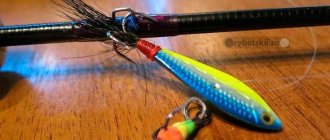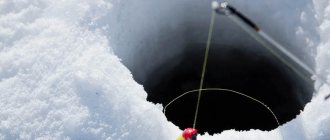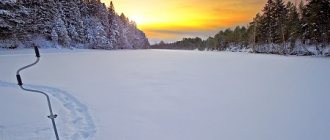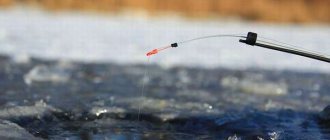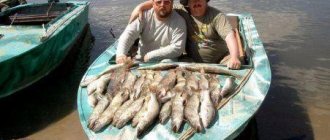When the summer fishing season ends, it's time for the winter season. Winter fishing is almost no different from summer fishing. But there is only one danger - you can fall through the ice. Therefore, you need to follow safety precautions and know what the thickness of the ice should be for safe movement on the surface. If you follow all the rules, winter fishing will become even more exciting than summer fishing.
Ice formation process
In early November, reservoirs and rivers begin to become covered with a thin ice crust. When exposed to cold, water crystallizes and creates a surface layer. Ice that can support the weight of a person is formed by the end of November - early December. But sometimes, due to the warm autumn, the ice crust begins to form only in December.
Early appearance of ice is possible only on those reservoirs that are located in northern latitudes. And already at the end of December you can safely move along it not only on foot, but also in other ways.
By this time, its thickness increases, and it can even support a car. The process of forming an ice layer:
- The surface of the required thickness is formed after the formation of the primary layer.
- First, water crystallizes, then ice lard forms.
- Ice lard gains mass and forms snow fields, after which ice cover begins to form.
- At this stage, loose and fragile ice of a pancake shape appears, in the form of ice floes that float separately.
- Then an ice crust appears. But usually its thickness does not exceed 5 cm, so it is unable to withstand the weight of the fisherman.
- The formed thin layer is slightly stronger than the rest. After it, a young layer appears - gray in color. When prolonged frosts set in, it gradually brightens and becomes white. This thickness is suitable for fishing.
The fishing season is open.
How temperature changes affect ice strength
We climbed in two teams along the frozen Khrapovsky waterfall. “Oh, I see the break line!” - said Ivan Temerev and climbed towards the horizontal crack along a separate icicle. I felt uneasy, even though I was climbing on reliable ice 20 meters to the right.
Let's figure out why free-standing ice columns crack and how to choose the time so as not to fall along with it.
Sharp temperature fluctuations weaken ice
It seems obvious: the colder it is, the more reliable the ice. But it is not always the case.
Ice expands when it's warm and contracts when it's cold. When the temperature changes gradually, the ice has time to adapt to the changes. If the temperature changes quickly, the ice will crack.
Researchers from Grenoble spent four years freezing temperature and pressure sensors into ice. They showed that the faster the temperature changes, the more fragile the ice becomes.
- Great, I'm happy for them. Why do I need this?
Consider temperature changes when choosing a route. It depends on how you spend the evening: at dinner with friends or in a hospital room.
The temperature stays around 0 °C: a little less at night, a little more during the day. In this case, the ice is plastic enough not to break off into pieces. The tool fits in securely from the first blow.
Temperatures above 0 °C day and night Melt water flows between ice and rock. If the icicle did not rest so much on its base as it held on to the rock, it could fall off. And water flowing into the sleeves will not add to the pleasure of the route. Not a good time for ice climbing, better wait until it gets colder.
Severe cold snap and cold after it Ice shrinks and becomes brittle. When struck by a tool, cracks appear and the entire icicle can be broken off. In addition, a frozen and shrunk icicle develops vertical stress, which can cause it to collapse.
Gradual cooling Ice is chipped by lenses, but the likelihood that an icicle will break off due to temperature changes is small. It can break simply because it is not strong enough.
Detailed research here: igsoc.org/journal/57/203/j10J172.pdf
That is, if the temperature has dropped by 10 degrees in a day, it is better not to climb free-standing icicles and waterfalls with a thin layer of ice. They may crack and fall off.
PS Ivan safely climbed over the crack in the icicle.
This is a free translation of an article from petzl.com, the pictures are also theirs.
Kirill Belotserkovsky, instructor of the Tuyuk-Su alpine camp
Here's another:
- At what angle should you screw the ice screws? How to screw the ice screws so that they hold securely in different types of ice.
- Alexander Veniaminovich Timofeev died On Friday, November 22, Alexander Veniaminovich Timofeev left us. He was one of the representatives of the era of Soviet mountaineering of the 70-80s, of which there are fewer every year. Alexander Veniaminovich did a great job of preparing rules and developing programs for mountaineering events in Kazakhstan. In Alplager he served as head of the rescue squad. A […]
- News from August We are here in the second half of August: warm, sunny and generally very healthy. Everyone goes to the mountains and to various interesting activities.
- The reverse side of the stirrup You can hang two people on one stirrup lanyard. One is at the end of the rope, the second is on the back of the stirrup.
Ice layer growth rate
If the weather is calm and the air temperature is -1 degree, then the rate of ice formation on lakes and ponds per day will be 2.5 mm. Theoretically, in 24 hours at an air temperature of -5 degrees, the thickness of the ice cover will become 12.5 mm. Growth on large rivers and reservoirs occurs differently. Unlike shallow water, deep water freezes more slowly. The growth does not become faster even when it snows. From a thick layer of snow, a thin layer of ice is slightly submerged. Small cracks form on the surface through which water seeps in, causing the ice coating to melt.
Test of strength
When you arrive fishing, the first thing you should do is check the surface for strength. It is very important! If it turns out to be thin, the ice will crack and the person will fall into the water. Test of strength:
- Before reaching the surface, they evaluate it. The color of the ice that can withstand a person will be blue or greenish, and its surface will be absolutely smooth, clean and transparent.
- The first steps on the surface are taken carefully. You need to return if, after walking a short distance, the ice under your feet begins to bend and crack. If the distance covered is long, then the first thing you need to do is distribute the weight correctly. To do this, they lie down with their legs spread apart and carefully crawl towards the shore.
- You can check the thickness using a stick or pick, which you always take with you. If you tap the surface with a stick and a characteristic crack appears, this means that it is very thin and fragile. Sometimes during such actions, water comes out.
You need to know that it is easy to fall into the water if you test your strength with a kick. Therefore, under no circumstances should this be done. You can determine that the surface is fragile and should not be accessed by the following signs:
- If the color of the ice is yellow or gray, then you cannot move on it. It is fragile and can fail immediately. In a few days, its thickness will become greater, then you can safely go fishing.
- Water flows out of the holes.
- The surface cracks or squishes.
- During a snowstorm, the snow freezes and the ice surface acquires a loose, spongy structure. You cannot go out on this ice if it formed after the first frost.
Today you can find out the strength and thickness of ice for fishing on a large body of water from the forecast of the Ministry of Emergency Situations, which are regularly published.
How to determine the thickness for fishing?
There are several ways to check the thickness of the ice on a pond yourself and protect yourself from falling under water.
Important!
When going out on the ice in winter, regardless of whether you are a fisherman or a person who just wants to shorten the path, you need to take an ordinary stick with you. The fragility of the ice ahead is always checked with a stick, since kicking can cause an instant fall into the water.
The ice is checked with a stick as follows: tap on the frozen surface and watch for the appearance of water. If water appears on the surface, the ice has not yet frozen sufficiently and it is completely unsafe to walk on it. There is a certain way to leave thin ice: move slowly, do not panic or make too sudden movements, your feet should slide along the surface and not come off.
The most dangerous places
Unformed or melted ice is considered dangerous. Therefore, in the spring and autumn, when it is just beginning to form or, on the contrary, has slightly thawed, you need to be especially careful. The most dangerous places:
- In the middle of the river the thickness is always less. The closer the coast, the thicker the ice cover becomes.
- Ice with snowdrifts or covered with a thick snow cover is very dangerous, since it is not visible under it what condition it is in.
- If there are fishing holes and holes on the surface, you can easily fall into them.
- You cannot go fishing during thaws. During this period, the ice thaws and becomes soft and friable.
- Swampy areas should be avoided. Because due to the gases released, the surface below is heated and becomes very thin.
Methods of transportation
In order not to drive a car on the ice, some fishermen leave it on the shore and then move on their own. Travel methods:
- By ski . When traveling on skis, it is enough for the thickness to be at least 8 centimeters. It is good if the surface is covered with a small layer of snow, since the skis slide too much on a clean surface. This method of transportation is often used by fishermen who come to fish by public transport.
- On snowmobiles . A snowmobile is a heavy vehicle and can only be used if its thickness is more than 15 centimeters. It is advisable to have a small layer of snow on the surface.
- Ice crossings . If you need to reduce the distance between two points, you can use legal ice crossings. The thickness in these places is more than 30 centimeters and you can easily move along them by car.
Ice on the pond
Kuzmin V. A. | March 12, 2000
Winter fishing is rightfully one of the most popular types of recreation. Once in a lifetime, you only have to pull out a 400-500 gram striped fish from under the ice, and for the treasured feeling of something weighty at the other end of the fishing line, a person can go almost to the ends of the world.
It is not surprising that the famous Italian psychologist Lombroso considered fishing and hunting forms of manifestation of schizophrenia... Indeed, how else can one explain the uncontrollable craving of fishermen to catch small things from two-centimeter ice or to swim on an ice floe because of a bag of smelt? One way or another, many of us often have to deal with problems related to the hydrological aspects of ice formation. Therefore, let me remind you of the most important properties of ice for an angler.
So, distilled water freezes at 0°C. As salinity increases, the freezing point decreases slightly. The low salinity of our water bodies allows this decrease to be neglected. When ice freezes, impurities remain in the form of gas bubbles rising from the bottom or filling cracks, salt solutions, and insoluble mineral particles. The presence of pores reduces the density of ice, increases its buoyancy and changes its thermal properties. The more through pores, the faster heat or cold penetrates into the ice.
For example, in places of abundant aquatic vegetation, as well as in areas of reservoirs where there was previously a swamp or forest, ice has a porosity of up to 50% and grows much faster than in clean water. At the same time, despite its greater thickness, its destruction occurs faster, so such places are the most treacherous. In much the same way, the strength and thickness of ice is affected by the direction of the wind in the first days of its formation. Near the shore, to which the wind blows pieces of young ice, sludge and fat, the ice mass grows faster, but it is not uniform, and, therefore, you need to be more careful here in the spring. In addition, some anglers point out that in such places the water is less saturated with oxygen throughout the winter, and therefore there are fewer fish here.
The density of ice depends on the rate of freezing. With slow freezing, the density increases due to swelling of the mineral layers. The average density of ice in freshwater bodies of the North-West is 0.91 g/cm3. This means that the height of the surface part is about 10% of the total height of the ice floe. In an extreme situation, such as jumping onto a floating ice floe, it would be useful to estimate the maximum weight it can support. The easiest way to do this is to calculate the number of cubic decimeters in the surface part and compare them with your own kilograms. For example, an ice floe as thick as an ice auger protrudes out of the water by about 5 cm. Let’s assume that you need to keep dry a gentleman weighing 80 kg in a sheepskin coat, with an ice auger, a box and a backpack. It is necessary that the ice floe can support 150 kg. Then its area should be equal
S = 150 kg : 5 cm = 30,000 cm3,
that is, it should have dimensions of 1m x 3m.
Obviously, young, homogeneous ice is the strongest. Some enthusiasts allow themselves to experiment with ice thickness of 2 cm. According to safety requirements, work on ice can only be carried out if the ice thickness is at least 5 cm. In order to reassure your wife, there is no need to run around with a ruler every day to the pond. Ice thickness can be calculated without leaving home.
Typically, empirical formulas of the type are used for this (where and n are empirical coefficients, and is the sum of negative temperatures at a height of 2 m). If the spirit of a researcher is alive in you, then you can independently simultaneously observe the air temperature using a regular thermometer and the thickness of the ice on your favorite body of water, then it is not difficult to construct a graph.
Using this graph, you can estimate the ice thickness for next year by monitoring the air temperature.
It is necessary to pay attention to the fact that in a flow, due to turbulent heat exchange with the flow, the thickness of the ice is always less. If you have to walk through a flowing area of a lake or reservoir, make appropriate adjustments. Ice grows slowest in the downstream of hydroelectric power plants: the deeper the reservoir in the upstream, the longer the polynya. Keep in mind that reservoirs tend to release sporadically in late winter and early spring, which also compromises ice strength.
During ice destruction, heat balance plays a lesser role than during ice formation. In spring, mechanical factors become decisive. On large bodies of water, these include, first of all, the influence of wind. The obvious fact is that the sharp protrusions of large ice floes break off first. However, please note that with wind speeds exceeding 15-20 m/sec, even intact ice fields can be destroyed, and this is what often destroys spring smelt lovers.
In conclusion, I would like to wish that the most thrilling sensations on winter fishing arise for you when pulling out trophies, and not for your loved ones - during your long absence.
Security measures
To avoid problems and various troubles during winter fishing, you need to follow a number of rules. Security measures:
- First, they determine whether the ice is durable or not, and only then stand on it.
- If there are well-trodden paths, then it is better to follow them.
- If the surface begins to crack, you need to return immediately.
- It is better to avoid places with many fishermen. Otherwise, the ice may crack due to excess weight.
- You cannot go out for winter fishing during heavy snowfall or rain, as well as at night and in heavy fog.
- To protect yourself in case of ice cracking, the ski bindings are unfastened. Do not put your hands in the loops of ski poles. The backpack is hung on one shoulder.
- Places with strong currents are avoided.
- If there are several fishermen, then during movement the distance between them should be at least 5 meters.
- You cannot jump on ice or ride on ice floes.
Travel rules
- When crossing a pond, try to stick to those areas where the path has already been trodden. When stepping onto clean ice without traces, be sure to probe the surface in front of you with a stick;
- if you are fishing in a group, you should spread out at some distance from each other;
- It is advisable to travel to the drilling site on skis;
- If you take a backpack with equipment with you, you should wear it with only one strap. This will allow you to quickly throw the load aside if you fall through the ice;
- Be sure to take a rope with you when fishing, the optimal length is 20-25 meters. A weight is attached to one end of the rope and a loop is made. This allows you to provide assistance to a fisherman who has fallen through the ice if necessary.
It is advisable not to go ice fishing on your own. It is also important to warn your loved ones about the exact place you plan to fish.
Rules of conduct in icy water
Sometimes it happens that a fisherman falls into the water. Recommendations for behavior:
- You can't panic.
- Heavy things that pull you down, throw them down and call for help.
- If water gets into the shoes, they are removed.
- In order not to sink to the bottom, you need to rest your hands on the edge of the ice. But be careful not to break off its edges.
- It’s easier to get out of a shallow body of water; just push off from the bottom and climb onto the ice. If the reservoir is deep, then they lean their whole chest onto the ice, and take turns pulling their legs to the surface. Then they carefully roll away from the hole and crawl towards the shore.
- If the shore is close, the reservoir is shallow, and the ice is thin, then its edges are easy to break. Breaking through the ice floe with your chest, you need to slowly and carefully move towards the shore.
- You can pull the fisherman out of the water using a rope or stick. The rescuer crawls towards the victim, throws him a stick and pulls him to the surface.
- If several fishermen fall into the water, they climb to the surface, helping each other. To prevent the ice from cracking from their weight, you must not stand up, you must remain in a lying position.
To avoid hypothermia, all rescue actions must be quick and coordinated. On the shore, the victim’s wet clothes are removed, the body is rubbed with alcohol or vodka, a hot liquid is given to drink, and an ambulance is called.
Rules of conduct when getting into water
- try to calm down, do not make too fast movements with your arms and legs;
- Do not wet your head under any circumstances;
- call loudly for help;
- try to cling to the ice;
- try to get out onto the icy surface, helping yourself with your feet. Don't stop trying if it doesn't work;
- if you manage to get out, slowly crawl to the shore without getting up; do not stop to rest outside, it is important to get to a warm room.
Winter fishing is quite a pleasant pastime. To prevent it from turning into an emergency, you need to carefully prepare and learn more about the thickness of the ice on the body of water where you plan to fish.
Subscribe to the
Cool !
Follow new posts, share with friends and like!



